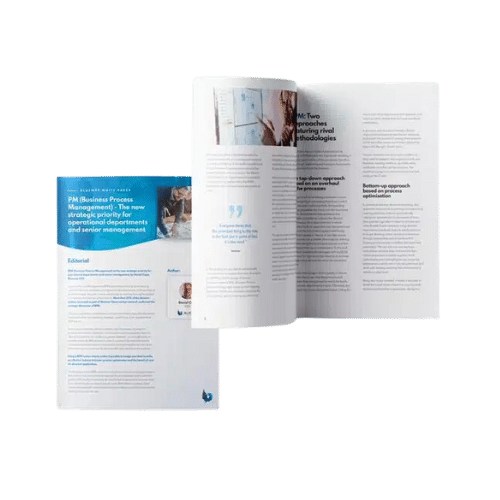The business view of a process encompasses data together with various stages and processing, etc. Sometimes a difference only shows once a business process is translated into an application. However, it is a mistake to compartmentalise data and processes. The business view must prevail, and it cannot be constrained by technical or system limitations.
It is this connection, the interoperability between data and processes that enables a process to truly be part of the information system, prevents a proliferation of applications and therefore ultimately improves the agility of the business and upgradeability of the information system. Blueway is a strong believer in this business-wide, shared view of processes and data.
Process mining in brief
Process mining is found where two fields overlap:
- Data science: data and data structures, centralisation, representation and display;
- Process management: modelling, automation and the linked execution of sequences of events.
Process mining consequently analyses data relating to process execution, with the aim of finding areas for improvement. It thus lies at the crossroads of BPM (Business Process Management) and data mining.
In summary, process mining is an examination of processes undertaken using the data that circulates in those processes. It therefore focuses on “facts”. Process mining and process intelligence are very similar ideas: business process intelligence (BPI) refers to the application of data mining techniques and process mining in the area of business process management (BPM).
A number of initialisms have emerged around these topics in recent years, such as BAM (Business Activity Monitoring), CPM (Corporate Performance Management) and CPI (Continuous Process Improvement).

Download our white paper on Business Process Management.
But what practical purpose does process mining serve?
In organisations, processes are everything. Each process will generate and change significant amounts of data over its lifetime. Multiply that effect by the number of processes in a typical organisation, and we get vast volumes of data, most of which is under-used.
Each application in the IS might, admittedly, analyse its own data. However, processes span the entire IS and data analysis should not be compartmentalised within individual applications. Process analysis therefore needs to occur at the functional business level if it is to be effective. It should also include event logs which are usually more or less disregarded in other analyses.
Process mining meets that need. It examines operational process data across the entire information system, irrespective of individual software components. It provides understanding of processes as they are actually run in the organisation.
It consequently delivers a number of benefits:
- Identify areas for improvement by process modelling (theory in the model versus practice in real life)
- Uncover operational improvements (bottlenecks, time taken, unnecessary steps, etc.)
- Forecast using test scenarios and potential optimisations.
It therefore entails not only “taking the pulse” of processes but also carrying out projections and simulations. Process mining is the link between process management and improving performance in organisations.
As process mining is largely automated (using algorithms, etc.) and based on actual IS data, the resources required from the business are limited. It is also an objective approach, based as it is on algorithms and real data.

Download our expert view on architecture re-engineering.
How process mining works
Process mining examines the actual use made of active processes using the information system’s transaction and event data.
This analysis takes place over a number of stages:
- Discovery stage: a picture of the real process, as it is actually run, using data from IS event logs. The complexity of the representation can vary depending on the objectives.
- Conformance checking stage: these processes reconstructed from real data are then compared with the corresponding theoretical model. This serves to show whether the organisation’s procedures and rules are being followed.
- Performance improvement stage: Normalised and consolidated data are shown in easy-to-use graphical formats, so that avenues for improvement can easily be seen.
Blueway and process mining
Our objective at Blueway is to bring the various dimensions of data interchange back together, and the process and data aspects in particular. We consequently aim to get people working on adding value and we use data to support that principle.
This is why the Blueway solution is the only platform blending BPM, MDM, ESB and API Management. It is this all-encompassing approach to data flows in business that led to Blueway incorporating this process mining component.

Want to discuss Business Process Management with an expert?





